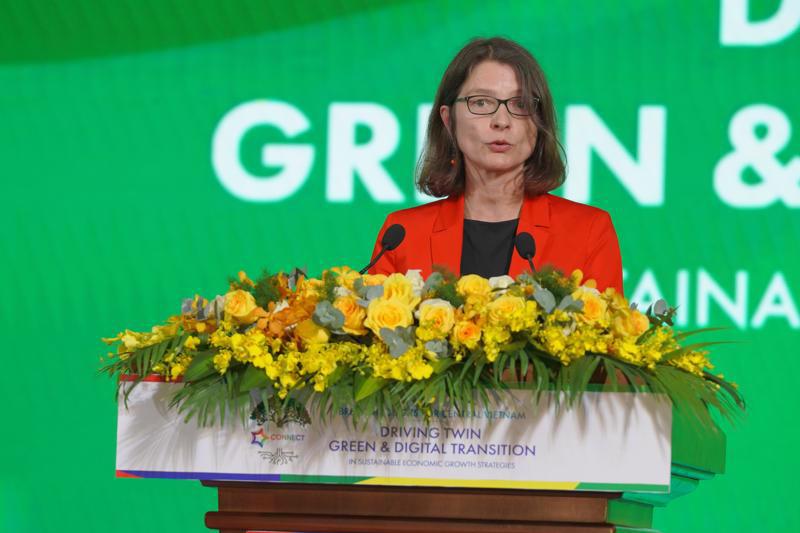Vietnam’s central region is facing two key challenges in green growth on both the adaptation side and the decarbonization side, according to Ms. Stefanie Stallmeister, Operations Manager for the World Bank (WB) in Vietnam.
“It is a timely moment to reflect on these two critical challenges as the region seeks to set the foundation for future growth,” she told the Vietnam Connect 2023 forum in central Da Nang city on March 17 with the theme “New Breakthroughs for Central Vietnam, driving twin green and digital transition in sustainable economic growth strategies”.
The forum was co-hosted by the Ministry of Foreign Affairs, VnEconomy / Vietnam Economic Times, and the Da Nang City People’s Committee.
Sea levels are rising, typhoons are strengthening, rainfall is more erratic, cities are experiencing more floods, farmers are facing drought, and people along the coast are facing a combination of erosion and salination. Natural risks to coastal communities are substantial and increasing. Nationwide, disasters cause well-being losses of $11 billion every year, with 60 per cent of this occurring in coastal regions, she said.
“Future climate change will increase these losses even further,” she went on. “Investments in adaptation are absolutely necessary to deal with immediate and worsening challenges. With respect to coastal areas alone, delaying action by ten years could expose an additional $4.3 billion of economic growth to natural shocks. An action plan and national investment program are urgently needed to address the risks and opportunities in coastal development.”
These investments have three features. Firstly, they are regional and not provincial in nature, because it is very hard to invest in coastal protection measures province by province and it is very hard to invest in river management province by province.
Secondly, investments must be climate resilient.
Thirdly, nature-based solutions should always be taken into consideration. These often have the twin benefit of managing the impact of climate change while also reducing emissions and making cities, coastlines, and forests more attractive.
Regarding the other side of green growth, which is the decarbonization agenda, she said that even though Vietnam is a low emitter of greenhouse gases by global standards, the carbon intensity of its growth is rising and this is a problem for a globalized economy.
“I need to underscore the importance of lowering the carbon footprint of Vietnamese exports to ensure that they remain competitive,” she said. “Consumers, importers, and investors are paying increasing attention to climate change mitigation efforts and may start deserting highly-polluting countries and industries going forward. The resource-intensive development model that allowed Vietnam to reach its current income level cannot be sustained in a world of climate change.”
“Because of this, it is time for the region to consider what low-emissions agriculture looks like, so that your agriculture exports remain competitive in global markets. It is time for your vibrant tourism sector to have access to renewable energy and sustainable solid waste management so you can continue to attract environmentally-conscious tourists. It is time to ensure that manufacturing industries in Thanh Hoa, Nghe An, and Ha Tinh provinces are able to access renewable energy sources and discharge zero waste, and that products can be exported through low-carbon logistics chains.”
She added that, at the same time, the expansion of renewable energy will present an opportunity for the region. Parts of the region have a strong comparative advantage in renewable energy, especially solar and wind. Attracting private sector investment into these sectors could provide an important economic boost and create jobs.
The World Bank representative also offered recommendations for the central region to boost green and sustainable growth, including having the approved Power Development Plan (PDP) 8 set a roadmap for green transition and identifying investments that can drive this transition, and accelerating procurement arrangements so that Electricity of Vietnam (EVN) can purchase renewable energy in a way that is predictable for private investors and ensures its own financial sustainability.
Regarding the digital economy, she said this is central to the need to intensify growth in productivity in Vietnam’s economy, and applies more broadly to the country’s approach to technology adoption.
Few countries have achieved high-income status without technology development and adoption. The Vietnamese Government’s support programs for technology upgrades are quite limited in both number of programs and volume compared to regional competitors such as Malaysia and Thailand, Ms. Stallmeister said.
She suggested studying the experience of some of Vietnam’s neighbors, such as South Korea, and how they were able to climb the technology ladder in a way that promoted productivity and rapid growth.









 Google translate
Google translate